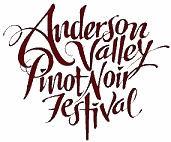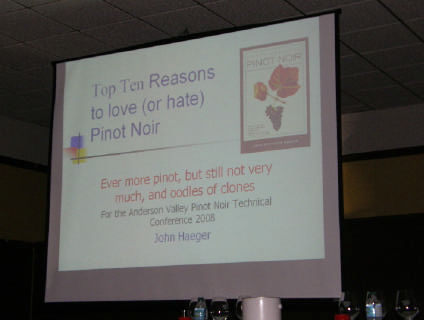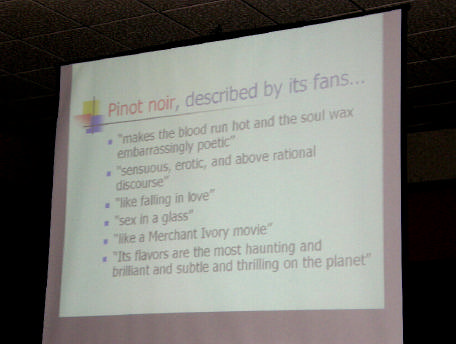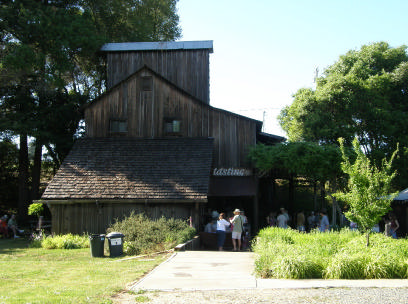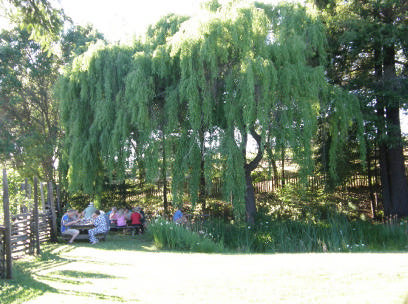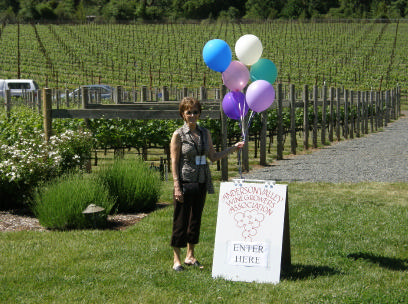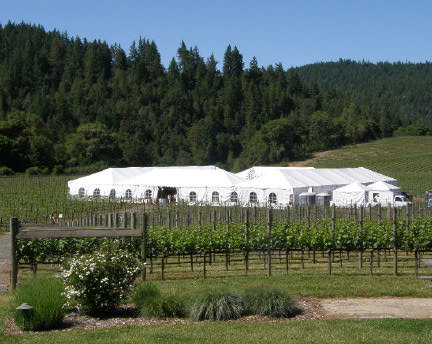2008 Anderson Valley Pinot Noir Festival
The Anderson Valley Pinot Noir Festival is a three day event. It began fifteen years ago with
winery open houses, but was formalized into a festival in 1997. The festival has increased in popularity over the last ten years
in step with the rise in quality of Anderson Valley Pinot Noir, and this year’s celebration was again sold out with 750 people
attending. The festival is held the third weekend in May each year. It is
one of my favorite annual Pinot events. I have become enamored by the
casual, country fair atmosphere, the delectable local artisan food, the
warmth and passion of the winegrowers, the cheerful organizers, and
the superb Anderson Valley Pinot Noirs which are now world-class, if
not other worldly.
Excerpts from the Technical Conference
May 16, 2008, Mendocino County Fairgrounds, Boonville, California
Ever More Pinot, But Still Not Very Much; and Oodles of Clones
John Winthrop Haeger, author North American Pinot Noir and Pacific Pinot Noir
If you get the opportunity to hear John Haeger speak about Pinot Noir, jump at the chance. He is a very
literate academic who is also quite humorous and happens to know more about the Pinot Noir grape
than anyone else on this planet. Although his talk was titled as above, he focused on “Top Ten Reasons
to Love (or Hate) Pinot Noir” to make his points.
#10 Pinot Noir remains the most lightly planted grape varietal in the world. It is low-yielding,
small-berried, thin-skinned and disease-sensitive.
#9 If Pinot Noir is mistreated, it will retaliate.
#8 Pinot Noir is hard not to love as some of its children are sweet and successful. There are at
least 16 offspring varieties: Auxerrois, Melon, Franc noir de la Haute Saone, Aubin nert,
Enard, Bechet noir, Roublot, Aligote, Romerentin, Saoy, Knipperie, Gamay noir,
Begunoir, Dameron, and Gamay blanc.
#7 Pinot Noir smells or tastes like almost everything good and bad. It mimics everything on the
aroma wheel.
#6 Pinot Noir attracts more “purple prose” than any other variety.
#5 Pinot Noir befuddles critics. Nobody knows what is supposed to taste like.
#4 Finally more and more is being planted. There has been a doubling of planting in the last
40 years, not in Burgundy’s Cote d’Or , but in Champagne, Languedoc (huge amounts), and Corsica. There are widespread reports that a new Two Buck Chuck
Pinot Noir will come from Corsica. Plantings have also increased in Germany and in
Switzerland. There has been a doubling of Pinot Noir plantings in Germany in the last
20 years, and close to a doubling in Switzerland. Some of the new plantings is replacing
white grape acreage. In the last ten years there has been a marked increase in
Pinot Noir acreage in New Zealand as well.
#3 There still is not a lot of Pinot Noir: 38,000 acres of Pinot Noir in North America and 160,000
acres worldwide (estimate). This is small in comparison to the worldwide 6,400,000
acres of wine grapes. There are 27,000 acres of Pinot Noir in California and 9,000 acres
in Oregon. Pinot Noir makes up 2% of the worldwide wine grape vineyard area and
about 1.1% of the worldwide wine production.
#2 If you love Pinot, which Pinot? All Pinot Noir came from a common source - one alpha vine -
either a domesticated wild vine or a wild vine crossed with a previously domesticated
vine or a neutral crossing of two previously domesticated varieties or a lab crossing of
two varieties. It first showed up in southeast France but not certain if it was Burgundy.
Pinot Gris, Pinot Blanc and Pinot Meunier are color mutations of Pinot Noir, not offspring
- all have the same parentage. “Clone speak can make you nuts.” It is a
jungle of alphanumeric shorthand. There are more than 800 clones of Pinot Noir in
conservatory collections in France. Of those, 43 are “approved.” 31 of the 43 are
widely distributed. 21 of the 43 +3 have UCD/FPS numbers. Haeger looked at all of
the Pinot Noir vines ordered from California nurseries in 2006-2007. Not all nurseries
responded but the following is clear. There were large orders for clone 23 (Muirfield
selection) in 2007 heading to Lodi and contracted to Gallo which is an astonishing
finding. Other orders were primarily for Pommard and Dijon (particularly 828 which is
the newest thing) clones. Eventually all clones will be doomed to further mutation and
the puzzle will continue to become more muddled and confusing. Despite all of the
interest and emphasis on Pinot Noir clones, it is clear that site trumps clone selection.
#1 People who make Pinot Noir are on the lunatic fringe. Enough said.
Direct Shipping Regulations
Annie Bones, State Relations Coordinator, The Wine Institute, San Francisco
State wine shipping regulations vary considerably from state to state and are still being actively legislated
in many states. If you have questions, consult Annie Bones at abones@wineinstitute.org or visit
the website at www.wineinstitute.org, where a state-by-state carrier status listing is available on the Wine
Institute website. Lets keep praying for as much reciprocity as possible.
Rootstocks for Pinot Noir
Dr. Andy Walker, University of California Davis Department of Viticulture and Enology,
Vitis vinifera is one of the most drought tolerant and lime-salt tolerant Vitis species. There are a variety
of rootstocks available, all offering differing amounts of vigor, varying degrees of resistance to
phylloxera, shallow or deep roots, and varying nematode resistance. Dr. Walker, a professor and
geneticist at University California Davis has been working over fifteen years to develop five new rootstocks
that are resistant to nematodes, aphids and other insects. The rootstocks have been licensed for
eventual sale (2010) by certified nurseries to vineyards. It is hoped that the new rootstocks can be
grafted to vinifera vines that are susceptible to these pests. Currently, Walker is recommending that
vineyards be planted to multiple rootstocks that are appropriate to the site, particularly ones that are
pest and drought resistant.
Pinot Noir in the Vineyard: Soil-Root Uptake, Soil Profiles and Flavors
Jessica Cortell, Premier Pacific Vineyards, Ginny Lambrix Viticulturist (De Loach, Ball Wines)
A few observations came out of this excellent discussion about realizing Pinot Noir’s phenolic potential
through viticulture.
* The quality of Pinot Noir improves as vine vigor decreases
* Low vigor is associated with darker wine color and increased tannins
* The management of tannins has become critical in viticulture as consumers look at texture as
one of the most important determining factors in evaluating the quality of Pinot Noir.
* Balanced vines deliver better flavors at lower Brix
* Indigent or native fermentation produces more esters and thus a bigger bouquet
* Biodynamic/organic farming creates a tremendous amount of life form in the top soil - a
teaspoon of soil contains one million bacteria, several yards of fungal hyphae, many
protozoans, and nematodes.
* Biodynamic/organic farming helps balance the vineyard, supports biodiversity and
competition, makes vines tougher and better buffered for tough times, and forces the
grower to do cultural practices on times.
Post Conference Barbecue
Following the conference, a casual barbecue was held at Standish Winery at the Day Ranch in Philo.
Attendees brought a wine or two to share so there was plenty to choose from. The buffalo burgers
were just the thing for some good Anderson Valley Pinot Noir. Standish Winery (the tasting room is
upstairs in an old redwood apple drying barn - pictured) was founded in 2004 by Ken and Miles
Oswald, longtime grape growers and winery principals. The winery sits on the Day Ranch which was
purchased by the Oswalds from the Day Family in 1978. The Oswalds are distantly related to the
famous Mayflower pilgrim, Miles Standish.
Grand Tasting of Anderson Valley Pinot Noir
Nearly 40 producers were pouring under the big tent at Goldeneye Winery in Philo on Saturday, May
17. There was a convivial atmosphere as attendees strolled through the tent, sampling both latest releases
and library wines. A gourmet luncheon was offered and thankfully there was plenty of water. It
was about 100°F and tasting large amounts of Pinot Noir is extremely challenging under these conditions.
One needs water to combat the drying effects of both alcohol and the heat and I think I went
through at least eight bottles over a couple of hours and still didn’t need to pee! That said, I enjoyed
myself immensely and I came away quite impressed with the general quality of the Pinot Noirs.
The Anderson Valley’s validation as a premium grape-growing area was first established by Roederer
Estate in the early 1980s and subsequently by Schraffenberger. Both made stellar sparkling wines from
clones planted for their value in making bubbly. In recent years there has been an emphasis on cultivating
Pinot Noir clones appropriate for still wine and widespread adoption of modern viticulture
advances. The result has been that the current class of Anderson Valley Pinot Noirs can hold their own
with any appellation in California. Winemakers and the trade seem to realize it, but the public perception
has lagged. With the small number of wineries and the anti-development attitude that pervades
the valley, recognition has been slow in coming. Retirees and urban refugees who are
seeking the wine lifestyle won’t find the creature comforts of Napa or Sonoma in Anderson Valley.
Many visitors to the valley simply pass through on their way to the Mendocino Coast, stopping only at
a few visible tasting rooms. Be advised, however, that this region and its marvelous wines are worth
exploring and I would encourage you to visit, lounge and really chill out a few days, and see what Pinot
Noir can really do here.
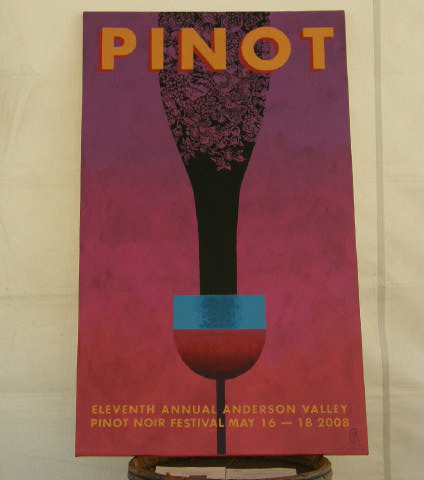
The Pinot Noir wineries of Anderson Valley are profiled in the following pages. Because of the heat on
the day of the Grand Tasting, I did not get to sample the Pinot Noirs from every producer present. For
some of the ones I missed, I tasted their wines at home after the event. In addition, I tasted a number of
releases from wineries outside the Anderson Valley who source grapes from within the appellation.
Like any appellation noted for Pinot Noir, there is a multiplicity of styles ranging from wines that are
forward and drinkable upon release to ones that need years to uncover deep-seated complexities that
lie within. There is something for everyone in the valley. Most of the producers' Pinot Noirs are very
sensibly priced and are worth pursuing. If you visit, be prepared to make an effort, as some wineries
are hidden in the hills several miles from the main thoroughfare and only reachable by lengthy, but
scenic, dirt roads.



